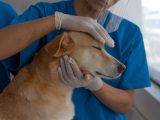
Four of the Most Common Orthopedic Issues in Dogs
March 6, 2023Dog orthopedic problems are common in a busy small animal veterinary clinic. Our canine companions are increasingly joining us in our athletic endeavors as society becomes more active. Running, chasing a ball, and catching a Frisbee can provide excellent exercise for dogs but can also be dangerous. Many breeds are genetically predisposed to muscular-skeletal disorders.
Diagnosis of Orthopedic Problems in Dogs
A veterinarian should evaluate orthopedic symptoms unrelated to a minor injury as soon as possible. Even a little limp should be considered if the limp lasts more than 48 hours. Because the signs of minor fractures, muscular strains and damage, cancerous conditions, and even bone degeneration are nearly identical, imaging technology is frequently used to distinguish between them.
A thorough physical examination in an in-house lab is usually followed by diagnostic blood tests like a complete blood count, urinalysis, and biochemical profile to rule out any imbalances or infections that could be causing your dog’s immobility. X-ray imaging and ultrasound technology are frequently used to improve the visibility of joints and bones.
Arthroscopy is sometimes used to better look at the ligaments and tendons surrounding affected joints. An endoscope is placed through a small incision into the joint to capture images of its interior during this surgical procedure.
These tests are frequently used to determine whether diseases like osteochondritis, arthritis, or bone trauma contribute to the disorder. If the examining veterinarian suspects arthritis, they may examine the joint capsule with a sample of lubricating synovial fluid. If it is your first vet visit, it’s understandable that you don’t feel at ease, but rest assured that they will do their best to ensure your pet gets better.
Canine Orthopedic Disorders
Dogs’ four most common orthopedic conditions are hip dysplasia, ruptured cruciate ligaments, patellar luxations, and disc issues.
Hip Dysplasia
Hip dysplasia is a genetic disorder that is influenced by a variety of factors. Large breed dogs, such as German Shepherd Dogs, Labrador Retrievers, and Golden Retrievers, are much more prone to it. As part of the treatment, anti-inflammatory drugs, which typically cost $2 to $3 per day, must be taken for the rest of one’s life. If the hips develop severe arthritis, titanium hip replacements, which cost between $2,000 and $3,000 each, are frequently required.
Because weight has a significant impact on the manifestation of hip dysplasia, prevention is critical. It has been shown that keeping your dog lean can reduce dysplasia by up to 30%. Weight loss is the most effective pain management method in humans and dogs.
Cruciate Ligaments Tears
How often do you hear that your favorite football player tore his ACL and will miss the entire season? The anterior cruciate ligament is responsible for proper knee function (ACL). A squirrel or rabbit is more likely to have injured your dog than a linebacker (and never caught it): the knee buckles, the dog zigzags, and the squirrel zigzags.
To prevent debilitating arthritis, animals, like humans, must have their torn cruciate ligaments surgically repaired. Depending on the dog’s size, the cost of various surgical procedures ranges from $1,500 to $2,500.
Disc Disease
Our dogs, like many others, may suffer from neck and back disc issues. Breeds such as Cocker Spaniels, Poodles, Dachshunds, and Lhasa Apsos can also suffer from neck disc issues, though giant-breed dogs are more likely to suffer from chronic lower back pain. Most of these cases are treatable with the same medications used to treat hip dysplasia. A ruptured disc necessitates immediate surgery. You can click here to request an appointment.
The material in the disc may entrap nerves or the spinal canal, causing excruciating pain or paralysis. These procedures are frequently completed in a matter of hours with positive results. These emergency back surgeries can range in price from $3,000 to $5,000.
Patellar Luxation
Many dog breeds are also prone to knee cap problems. The patella, or kneecap, rests in a groove. The medical term for the tendency of smaller dogs’ patellas to slip out of the groove to the inside or medially is medial patellar luxation. In small dogs, treatment for medial patellar luxation typically costs between $1,000 and $1,200. Patellas frequently slide laterally or outward in larger dogs. These dogs often have more complicated leg bone issues, making repair more complex and potentially expensive ($3,500).




